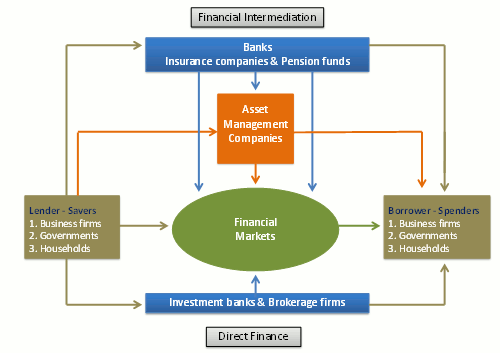Saving-Investment Spending Identity
Saving-investment spending identity
- Fact of accounting is that they are always equal for the economy as a whole
Imagine a country with no government and no trade
Y = C + I
Total Income = Total Spending
Total Income = Consumer spending + Savings
Total spending = Consumer spending + investment spending
Therefore Savings = Investment spending
Budget Surplus and Deficit
Sometimes, the government will "save" money and in other years, it will spend more than its revenue collected in taxes
Budget surplus
- occurs when government revenue exceeds government spending
Budget deficit
- occurs when government spending exceeds government revenue
Budget balance
- difference between government spending and revenue (either deficit or surplus)
National savings
- private savings + budget balance
Capital Inflows and Outflows
Countries receive inflows of funds and also generate outflows of funds
Capital inflow
- net inflow of funds into the country

In 2008, the United States had capital inflows totaling $707 billion, meaning the US is an attractive place to save money
Total investment spending = $ 2,632 billion
Private savings = $2,506.9 billion
Budget deficit = $683 billion
Capital inflows = $707 billion
National Savings = Private Saving - Budget Deficit
National Savings + Capital Inflow = $2,530.9
Statistical discrepancy = Investment - Savings = $101.1 billion
Tasks of a Financial System
Reduce Transaction Costs
Companies will get loans from banks or issue bonds to raise money
To get a comparable amount form individuals would be logistically difficult if not impossible
Reduce Risk
People have various levels of risk tolerance, so financial systems reduce risk through diversification
Sole ownership of a $1 billion company would be risky
Provide Liquidity
Having access to cash is critical
Liquid assets are generally preferred to illiquid assets
Types of Financial Assets

Bonds
An IOU issued by the borrower with the seller of the bond paying a fixed yearly interest and principal at the end of the term of the loan
The higher the default risk, the higher the interest rate
Loan-backed securities
Loans that are packaged together & sold as assets
Financial crisis of 2008, in part, because high rate of mortgage-backed securities defaulted
Stocks
Direct ownership in a company
Owning one share of Apple (AAPL) means you own 1/900,000,000 of the company
Financial Intermediary

Institutions that transforms funds gathered from many individuals into financial assets
Mutual Funds
Pension Funds
Life Insurance Companies
Banks
About 75% of wealth in the United States is held through these four types of financial intermediaries rather than directly through cash
Mutual Funds
Financial intermediary that creates a portfolio of stocks and/or bonds and then sells shares to individual investors
Major benefit includes diversification of investments rather than owing one single stock
Major downside would be the inability to hit a "homerun" with one single stock
In the United States, households own over $10 trillion in mutual funds
Fidelity Investments (2013) had ~$1.8 trillion in assets under management
Pension Funds
Pension funds are mutual funds that hold assets for its members to provide retirement income
Two of the largest pension funds in the United States are CalSTRS and CalPERS
California teachers opt out of Social Security (6.2%) and pay into CalSTRS (8%)
Life Insurance Companies
Life insurance companies take in premiums from policyholders and make payments to beneficiaries upon death of insured
Term, ROP Term, Universal, Whole
Life insurance companies pool together individual premiums, make various investments and do their best to avoid making payouts
Banks
Banks accept funds from depositors
Banks keep only a fraction of a customers' deposits in the form of cash
Most deposits are lent out to businesses, home buyer and other borrowers
Banks lends for long period of times but subject to the condition that its depositors could demand funds at any time
The Federal Deposit Insurance Corporation (FDIC) insures up to $250,000 for each account
Practice Questions
Reducing which of the following is a task of the financial system
a. Transaction costs
b. Risk
c. Liquidity
Answer: a & b
Which of the following is NOT a type of financial asset
a. Loan-Backed Securities
b. Bonds
c. Bank Deposits
d. Stocks
e. Car
Answer: e
The federal government is considered to be "saving" money when
a. There is a budget deficit
b. There is a budget surplus
c. There is no budget surplus or deficit
d. Saving does not equal investment spending
e. National savings equals private savings
Answer: b
A nonprofit institution collects the saving of its members and invest those funds in a variety of assets so that it can provide retirement income to its members is called which of the following?
a. Mutual Fund
b. Life Insurance Company
c. Pension Fund
d. Credit Union
e. Bank
Answer: c